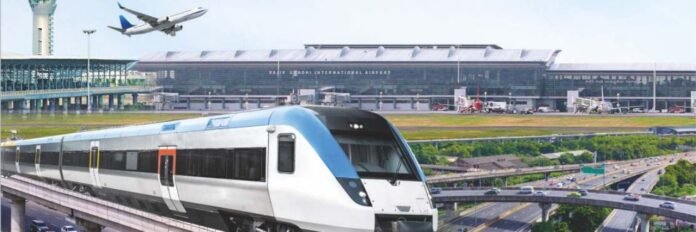By Shashank Pasupuleti
Hyderabad, renowned for its considerable metro community, is set to witness the addition of 9 new metro stations as part of the ambitious Airport Metro venture initiated through the Telangana authorities. The Hyderabad Airport Metro Rail Corporation has recently disclosed the precise locations where these stations will be established.
Demonstrating its commitment to the Airport Metro project, the Telangana government has dedicated substantial resources to its realization. In December, Chief Minister KCR laid the foundation stone, and subsequent surveying, peg marking, and alignment confirmation works have already been accomplished. The government has now invited global tenders for the construction phase of this crucial transportation venture.
The Rayadurgam Airport Station will serve as the inaugural point of the Airport Metro, situated at a distance of 0.9 kilometers from the Mind Space intersection. The route commences there, traversing two flyovers at the Biodiversity intersection before continuing alongside the Khajaguda pond. Upon reaching Khajaguda, it takes a right turn, passing through Nanakramguda Junction, Narsinghi, Appa Junction, Rajendranagar, and Shamshabad, ultimately arriving at the Airport via the Airport Cargo area.
The estimated length of the Airport Metro is 31 kilometers, with the Telangana government projecting a budget of Rs. 6,250 crore for the project. The state government has committed to financing the entire cost. Notably, whereas Hyderabad’s existing metro system predominantly operates above ground, the Airport Metro will introduce a subterranean component. An underground passage will be constructed in close proximity to the airport to facilitate seamless connectivity.
The 31-kilometer route primarily traverses the skies, covering a distance of 27.5 kilometers elevated above the ground. An additional kilometer travels at road level, while the remaining 2.5 kilometers operates underground. The selection of station locations was carefully determined, taking into consideration the areas of significant development. The route encompasses a total of nine stations, with the provision for constructing four additional stations, if deemed necessary.
Rayadurgam serves as the inaugural station on the route, followed by stations at Biodiversity Junction, Nanak Ranguda Junction, Narsingi, Appa Junction, Rajendranagar, Shamshabad Town, the Airport vicinity along the National Highway, and finally, a station situated within the airport terminal itself. To enhance passenger convenience, skywalks will be constructed in these areas.
In contrast to the existing city metro system, which operates at a speed of 80 kilometers per hour, the Airport Metro Rail is engineered to achieve a maximum speed of 120 kilometers per hour. The construction of the track will incorporate modifications to improve aerodynamics and facilitate faster train travel. The implementation of lightweight stainless steel and aluminum coaches will contribute to achieving this remarkable speed.
To enhance the overall passenger revel in, the airport metro stations will feature dedicated boards showing real-time flight arrival facts. Furthermore, in collaboration with the Central Industrial Security Force (CISF), stringent security measures will be implemented, together with bags screening earlier than entry into the airport. Once completed, the Airport Metro will facilitate seamless travel from Rayadurgam to Shamshabad, covering a distance of 31 kilometers in a mere 26 minutes. This not only reduces travel time but also promises to alleviate the cost burden associated with airport transportation.
Diverging from the seating arrangements commonly observed in the existing Hyderabad metro system, the Airport Metro will adopt a different approach. The placement of chair car seats will be optimized to accommodate more passengers comfortably, allowing for a more efficient utilization of space.



 Afrikaans
Afrikaans Albanian
Albanian Amharic
Amharic Arabic
Arabic Armenian
Armenian Azerbaijani
Azerbaijani Basque
Basque Belarusian
Belarusian Bengali
Bengali Bosnian
Bosnian Bulgarian
Bulgarian Catalan
Catalan Cebuano
Cebuano Chichewa
Chichewa Chinese (Simplified)
Chinese (Simplified) Chinese (Traditional)
Chinese (Traditional) Corsican
Corsican Croatian
Croatian Czech
Czech Danish
Danish Dutch
Dutch English
English Esperanto
Esperanto Estonian
Estonian Filipino
Filipino Finnish
Finnish French
French Frisian
Frisian Galician
Galician Georgian
Georgian German
German Greek
Greek Gujarati
Gujarati Haitian Creole
Haitian Creole Hausa
Hausa Hawaiian
Hawaiian Hebrew
Hebrew Hindi
Hindi Hmong
Hmong Hungarian
Hungarian Icelandic
Icelandic Igbo
Igbo Indonesian
Indonesian Irish
Irish Italian
Italian Japanese
Japanese Javanese
Javanese Kannada
Kannada Kazakh
Kazakh Khmer
Khmer Korean
Korean Kurdish (Kurmanji)
Kurdish (Kurmanji) Kyrgyz
Kyrgyz Lao
Lao Latin
Latin Latvian
Latvian Lithuanian
Lithuanian Luxembourgish
Luxembourgish Macedonian
Macedonian Malagasy
Malagasy Malay
Malay Malayalam
Malayalam Maltese
Maltese Maori
Maori Marathi
Marathi Mongolian
Mongolian Myanmar (Burmese)
Myanmar (Burmese) Nepali
Nepali Norwegian
Norwegian Pashto
Pashto Persian
Persian Polish
Polish Portuguese
Portuguese Punjabi
Punjabi Romanian
Romanian Russian
Russian Samoan
Samoan Scottish Gaelic
Scottish Gaelic Serbian
Serbian Sesotho
Sesotho Shona
Shona Sindhi
Sindhi Sinhala
Sinhala Slovak
Slovak Slovenian
Slovenian Somali
Somali Spanish
Spanish Sundanese
Sundanese Swahili
Swahili Swedish
Swedish Tajik
Tajik Tamil
Tamil Telugu
Telugu Thai
Thai Turkish
Turkish Ukrainian
Ukrainian Urdu
Urdu Uzbek
Uzbek Vietnamese
Vietnamese Welsh
Welsh Xhosa
Xhosa Yiddish
Yiddish Yoruba
Yoruba Zulu
Zulu